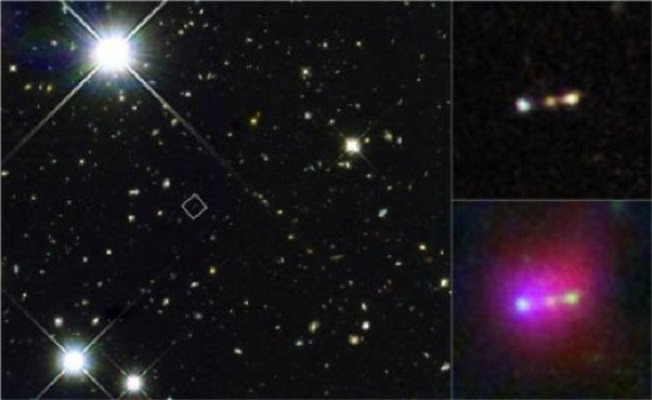Astronomers Probing 'Space Blob' Himiko Discover its Birth at Cosmic Dawn

Astronomers are preparing to take a closer look at a huge "space blob" – a very primitive galaxy called Himiko after a legendary Queen of Japan.
Himiko was first discovered in 2009 through the Subaru Telescope in the National Astronomical Observatory of Japan. It is an enormous galaxy, extending over 55,000 light years, with a hot glowing gaseous halo. It is seen at a time around 800 million years after the Big Bang, when the universe was around 6% of its current size and galaxies were starting to form.
Astronomer Richard Ellis, with colleagues from the University of Tokyo and the Harvard-Smithsonian Center for Astrophysics, examined Himiko with observations from the Hubble Telescope and the Atacama Large Millimeter/submillimeter Array (Alma). They were looking to establish the source of energy powering Himiko.
Images from Hubble showed three stellar clomps covering 20,000 light years. Each was the size of a normal luminous galaxy.
Together, the clumps produced stars at a fast rate – around one hundred solar masses every year. This finding, the astronomers say, explains Himiko's existence as it is the result of a "triple merger", what Ellis says is a "remarkably rare event".

However, Himiko also threw up some more puzzling readings. Alma showed the space blob was not bustling with energy at ultraviolet and optical frequencies, as would be expected from giant gas clouds.
Alma did not receive radio signals that would suggest heavy elements such as carbon, oxygen and silicon were present. The lack of carbon was also perplexing because gaseous carbon is common in galaxies with intense star formation..
Rather than finding elements typical in energetic galaxies, Ellis and the team found Himiko is composed of hydrogen and helium, which are primitive materials formed in the Big Bang itself.
The team concluded that Himiko is probably a primordial galaxy caught in the moment of its formation, between 400 million and one billion years after the Big Bang – known as the cosmic dawn.
Ellis said: "Astronomers are usually excited when a signal from an object is detected but in this case it's the absence of a signal from heavy elements that is the most exciting result."
© Copyright IBTimes 2025. All rights reserved.






















